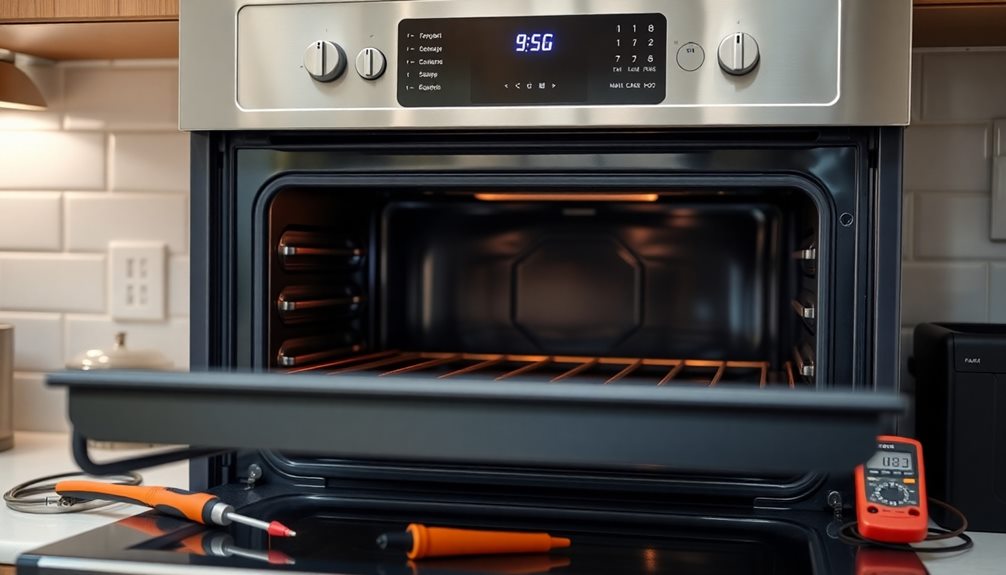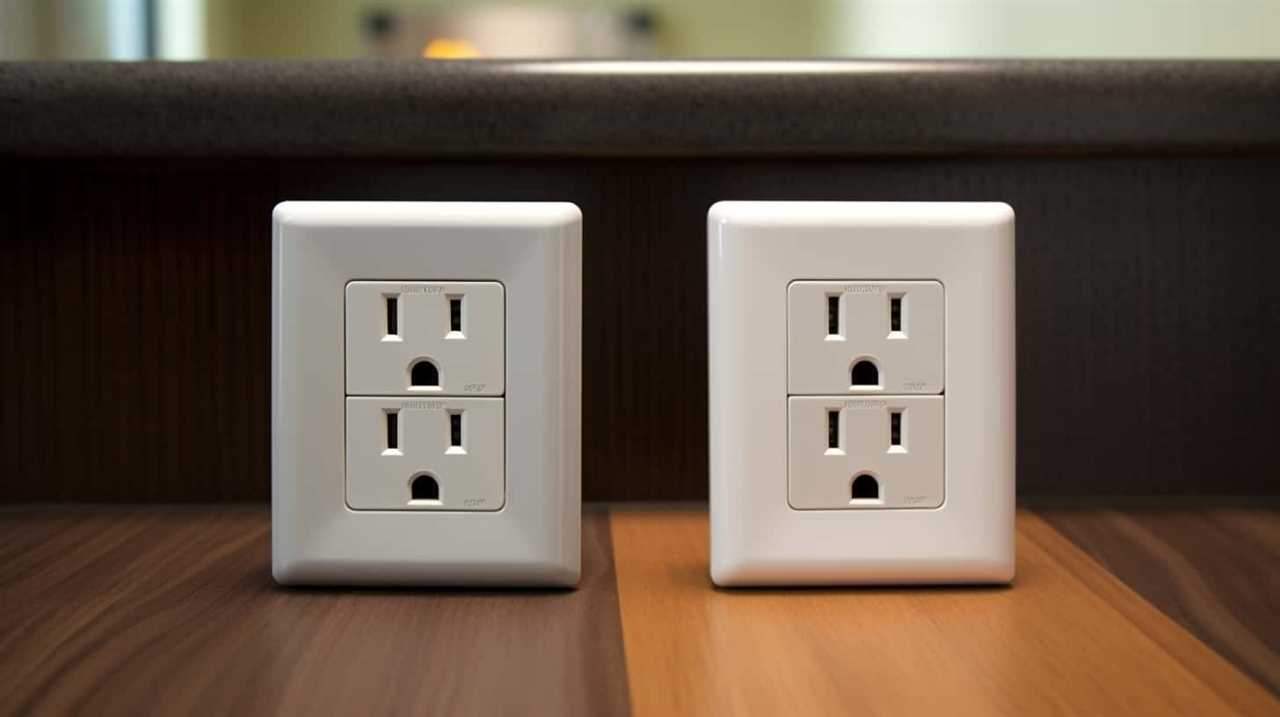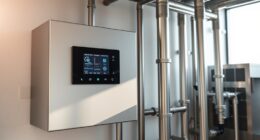If your GE dishwasher isn't getting water during the wash cycle, it could be due to several issues. First, check the water inlet valve for clogs or damage, as this can restrict flow. Verify the float switch moves freely and isn't stuck, which can block water entry. Look for kinks or blockages in the hoses that may disrupt water supply. Also, confirm that the door shuts securely, as it must be closed for filling. Regular maintenance, including cleaning filters, can prevent these problems. Keep exploring to find more troubleshooting tips and solutions.
Key Takeaways
- Inspect the water inlet valve for clogs or damage that may restrict water flow into the dishwasher.
- Check the float switch for obstructions; ensure it moves freely to allow proper water filling.
- Examine hoses for kinks or blockages that could disrupt water supply during the wash cycle.
- Confirm the dishwasher door closes securely; a faulty latch may prevent water from entering.
- Clean the dishwasher filter regularly to prevent buildup that can impact water circulation and cleaning performance.
Common Causes of Water Issues
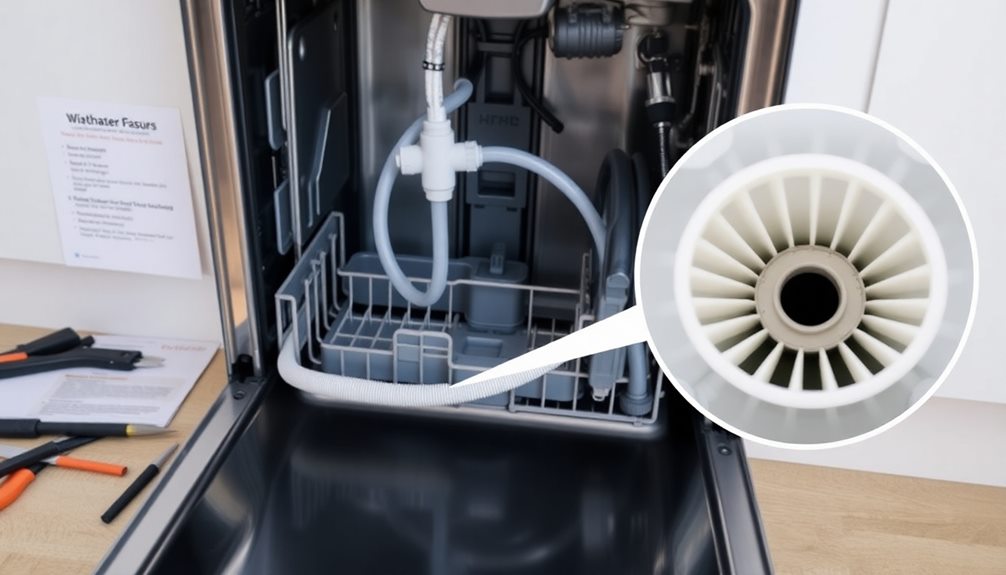
When your GE dishwasher isn't getting water, several common issues could be the culprit. One likely offender is the water inlet valve. If it's clogged or damaged, you might hear a squealing noise during the filling process, indicating it's not allowing water to flow in.
Another possibility is a malfunctioning float switch. If this component gets stuck, it may signal that the dishwasher is already full, preventing any water from entering when it's actually empty.
Additionally, check for a clogged filter. Over time, food debris can accumulate and obstruct water circulation, leading to dirty dishes and ineffective wash cycles.
If your dishwasher is humming but not filling, you might also want to inspect the hoses. A kinked or blocked hose can prevent water flow, which is often indicated by that same humming sound without any water entering.
Checking the Water Supply

Before troubleshooting further, it's important to check the water supply to your GE dishwasher. First, verify the water supply valve is fully open. A partially closed valve can restrict water flow into the dishwasher, leading to inadequate washing performance.
Next, inspect the water inlet hose for any kinks or blockages that could prevent water from reaching the appliance effectively.
Don't forget to check the water inlet valve itself. If this valve is clogged or damaged, it won't allow water to enter the dishwasher. You might need to clean or replace it to restore proper function.
Additionally, measuring the water pressure is vital; it should be above 20 PSI. Insufficient water pressure can lead to inadequate water supply during wash cycles, so confirm that your home's water pressure meets this requirement.
Inspecting the Float Switch

The float switch is an essential component in your GE dishwasher, acting as a water level gauge that guarantees the appliance fills only when necessary. If the float switch is malfunctioning, it may prevent water from entering the dishwasher, resulting in poor cleaning performance.
To avoid this issue, you should regularly inspect the float switch for any blockages or debris that could impede its movement. Check that the float switch moves freely up and down; any signs of sticking or damage could indicate it's time for a replacement.
A clean float switch is vital for proper water filling, so make certain to clear any dirt or grime around its area. If you find debris, simply clean it off to confirm ideal functionality.
Keeping an eye on the float switch can save you from headaches down the line. If you notice persistent issues even after cleaning, it may be time to consult a professional or consider replacing the float switch altogether.
Evaluating the Water Inlet Valve
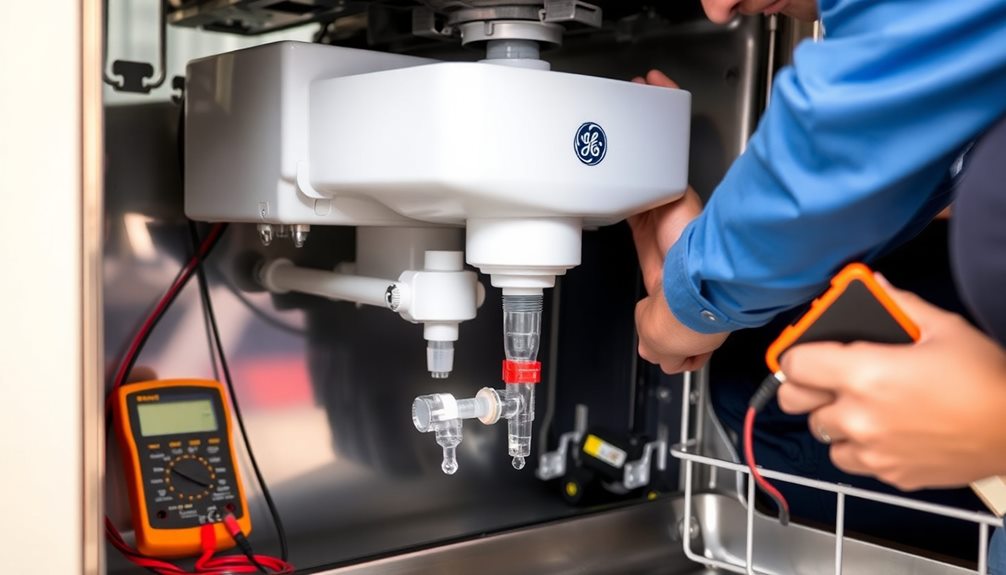
How can you assure that your GE dishwasher fills with water properly? One key component to check is the water inlet valve. This valve controls the flow of water into your dishwasher, and if it's malfunctioning, you might face issues during the wash cycle.
Here are some signs that your water inlet valve may need attention:
- Unusual noises during filling, like squealing
- No water entering the dishwasher at all
- Visible signs of wear or clogging
To evaluate the water inlet valve, start by turning off both the water and power supply. Once that's done, visually inspect the valve for any clogs or damage.
If you notice it's clogged or in poor condition, it's best to replace it to restore proper water flow. Regular maintenance, including checking the water inlet valve for debris, can prevent future clogging and keep your dishwasher running smoothly.
Assessing Door Closure Problems
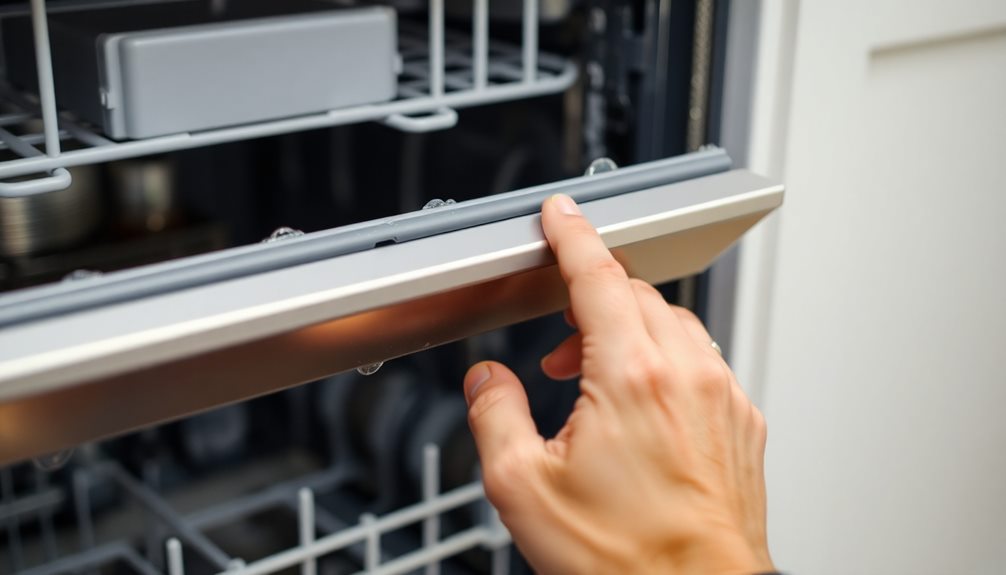
Have you checked the door closure on your GE dishwasher? The door switch plays an essential role in guaranteeing your dishwasher operates only when the door is securely closed. If it thinks the door is ajar, it won't allow water filling during the wash cycle.
Start by inspecting the door for any obstructions that might prevent it from closing fully. A simple blockage could be the reason for your water issues. Next, take a good look at the door latch. If it's worn or damaged, it may not engage properly, hindering the door switch's functionality.
Here's a quick checklist to help you:
| Check | Action |
|---|---|
| Door Obstructions | Clear any visible blockages |
| Door Latch Condition | Inspect for wear/damage |
| Door Switch Function | Test or replace if necessary |
Regular maintenance can help you avoid these issues. If your dishwasher still runs without water after confirming the door is closed, it might be time to test or replace the door switch. Taking these steps can restore proper function and guarantee your dishwasher works effectively.
Troubleshooting Kinked Hoses
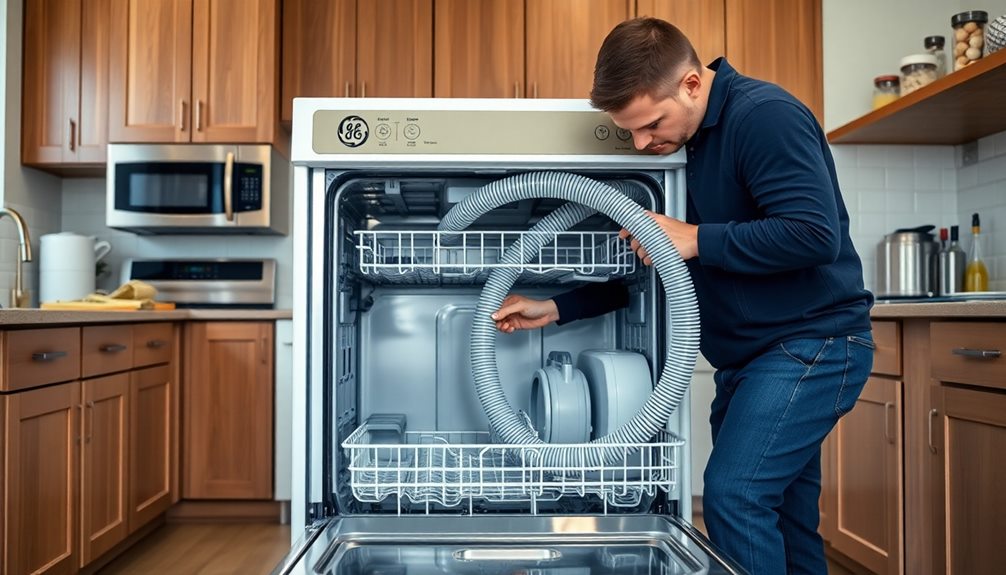
If your GE dishwasher isn't getting water, it might be due to kinked hoses.
Start by inspecting the entire length of the hose for any bends or blockages, as these can disrupt water flow.
Clear any obstructions promptly to guarantee your dishwasher runs efficiently.
Inspect Hose Conditions
Before diving into troubleshooting your GE dishwasher, it's crucial to inspect the hose conditions, as a kinked or blocked hose can greatly disrupt water flow. A malfunctioning hose can cause operational issues, resulting in dirty dishes and frustrating wash cycles.
Here's what to look for:
- Listen for a humming sound from the dishwasher without water entering.
- Check for any leaks around the hose connection.
- Look for visible kinks or blockages in the hose.
Start by turning off the water supply to guarantee safety and prevent any spills.
Once that's done, carefully examine the hose for kinks. If you find any, straighten them out to restore proper water flow. Also, remove any visible blockages that might be impeding the water.
If your hose is older than 5-7 years or if kinks persist after straightening, it might be time to replace it to avoid future problems.
Addressing hose conditions can greatly enhance your dishwasher's performance and guarantee your dishes come out clean after every cycle.
Clear Blockages Promptly
Once you've checked the hose conditions, it's time to address any blockages that might be affecting water flow. If your dishwasher isn't getting water, a kinked hose could be the culprit.
Start by turning off the water supply and examining the hose connected to the water valve. Look for any bends or obstructions that might impede water flow.
You might notice signs like a humming sound with no water entering the machine or even leaks around the appliance. If you find any kinks, straighten them out carefully to restore proper water supply.
It's important to remove any blockages to guarantee effective cleaning cycles for your dishes.
If you discover the hose is older than 5-7 years and issues persist, consider replacing it. Regular checks for wear and tear can prevent future blockages and keep your dishwasher running smoothly.
Cleaning the Dishwasher Filter
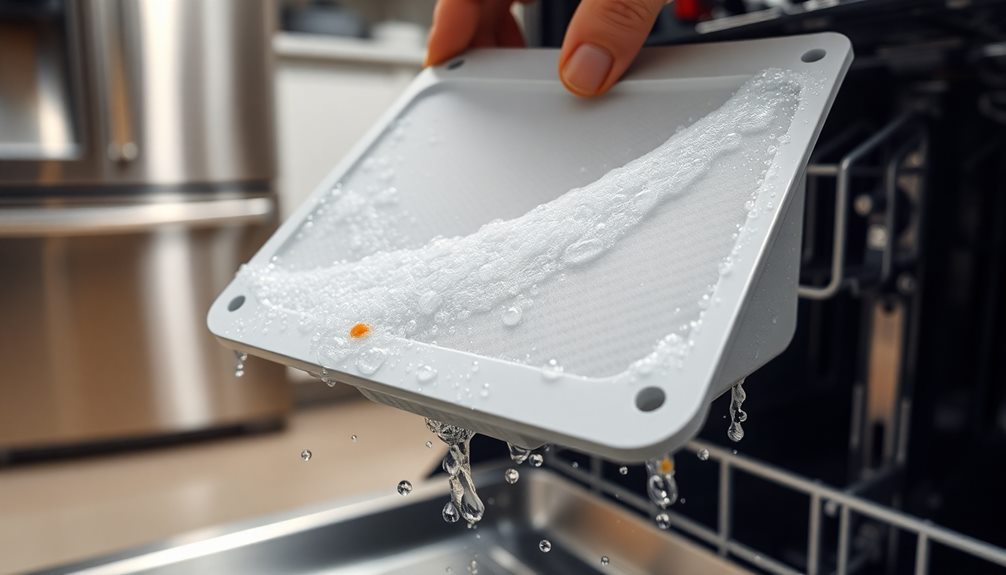
Cleaning the dishwasher filter should be a regular part of your maintenance routine, as it plays an essential role in keeping your appliance running smoothly. The filter, located at the bottom of the dishwasher, traps food particles and debris during the wash cycle, guaranteeing peak water circulation.
If you let the filter get clogged, you'll likely find that your dishes aren't getting clean, even after a full wash.
To keep your dishwasher in tip-top shape, consider these points:
- A clogged filter can lead to poor cleaning performance.
- Regular cleaning of the filter can prevent buildup and maintain efficiency.
- Replace the filter if it's worn or damaged after cleaning.
To clean the filter, start by removing it from the dishwasher. Rinse it under warm water to dislodge any particles, and if necessary, use a soft brush to scrub away stubborn debris.
Aim to perform this maintenance at least once a month to guarantee your dishwasher operates effectively. By focusing on cleaning the filter regularly, you can help avoid issues that could lead to your GE dishwasher not getting water during the wash cycle.
User Experiences and Solutions
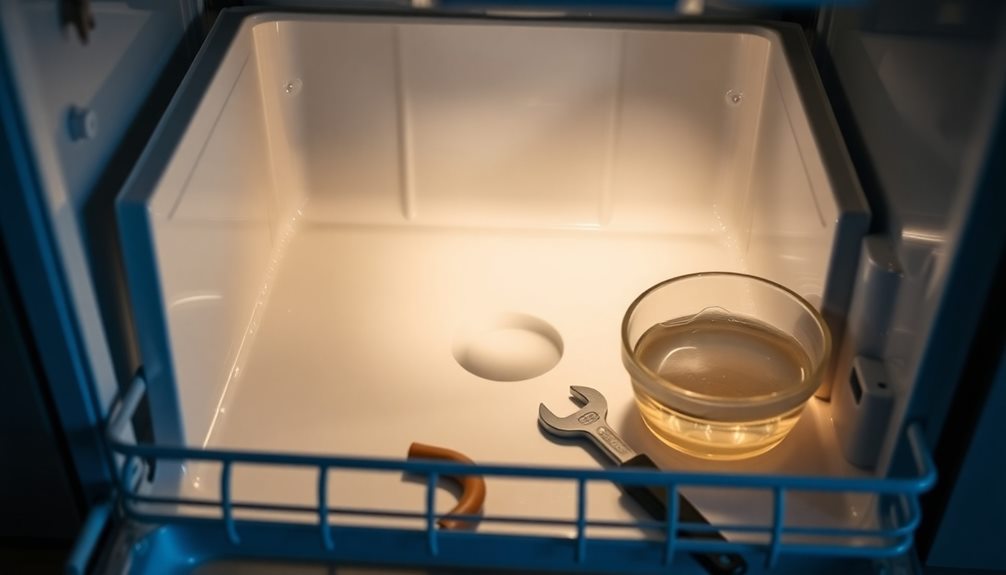
You've likely faced issues with your GE dishwasher not getting water, and you're not alone.
Many users have shared effective troubleshooting tips and temporary solutions that can help you get it running again.
Let's explore common problems and community support that can guide you in resolving these frustrating situations.
Common User Issues
Many GE dishwasher users encounter frustrating water entry issues that can disrupt their cleaning routines. If you find your GE dishwasher not filling, several common problems might be at play. Addressing these issues early can save you time and hassle.
- A stuck float switch can prevent water from going into the dishwasher. Cleaning the area around it often resolves the problem.
- Kinks or blockages in the water feed hose can greatly hinder water flow during cycles. Always inspect this hose for any obstructions.
- Debris accumulation in the dishwasher base can interfere with the float switch's operation, leading to water filling issues. Regular cleaning can help.
Additionally, an inlet valve that's clogged may also be the culprit. Inspecting and cleaning this valve is essential for ensuring a proper water supply during operation.
Many users recommend incorporating regular maintenance practices, such as cleaning filters and inspecting spray arms, to avoid similar water entry problems in the future. By proactively addressing these common issues, you'll keep your GE dishwasher running smoothly and efficiently.
Effective Troubleshooting Tips
When tackling water entry issues with your GE dishwasher, it's vital to take a methodical approach based on user experiences. Start by checking the float switch—if it's stuck or blocked, it could signal that your dishwasher is full, preventing water from filling. Clear any obstructions to guarantee proper functionality.
Next, inspect the water inlet valve. Users have found that debris can accumulate and clog this valve, leading to reduced water flow. Cleaning it can greatly improve water entry during cycles.
Don't forget to examine the hoses; make sure they aren't kinked or blocked, as this can also impede water supply. A simple visual check can save you from further complications.
Lastly, confirm the door closes securely. A malfunctioning door switch might signal that the door is ajar, causing the dishwasher to withhold water.
Regular maintenance, like cleaning the filter and inspecting the spray arms, is also imperative for peak performance. By following these effective troubleshooting tips, you can resolve water entry issues and get your GE dishwasher back on track.
Community Support Solutions
Have you ever faced a frustrating moment with your GE dishwasher not getting water? You're not alone! Many users in the community have shared similar experiences, and their insights can guide you through the troubleshooting process.
Here are some common solutions that might help:
- Check the float switch and clean its area to eliminate blockages.
- Inspect the water inlet valve for clogs and guarantee adequate water pressure.
- Consider adding water manually as a temporary fix while you investigate further.
Engaging with community members can provide you with diverse perspectives and practical advice tailored to your dishwasher model.
Users often recommend thoroughly checking hoses and filters, as blockages in these areas can lead to water fill issues. By sharing your problem online, you might discover unique solutions or tips that others have successfully implemented.
Maintenance Tips for Optimal Performance
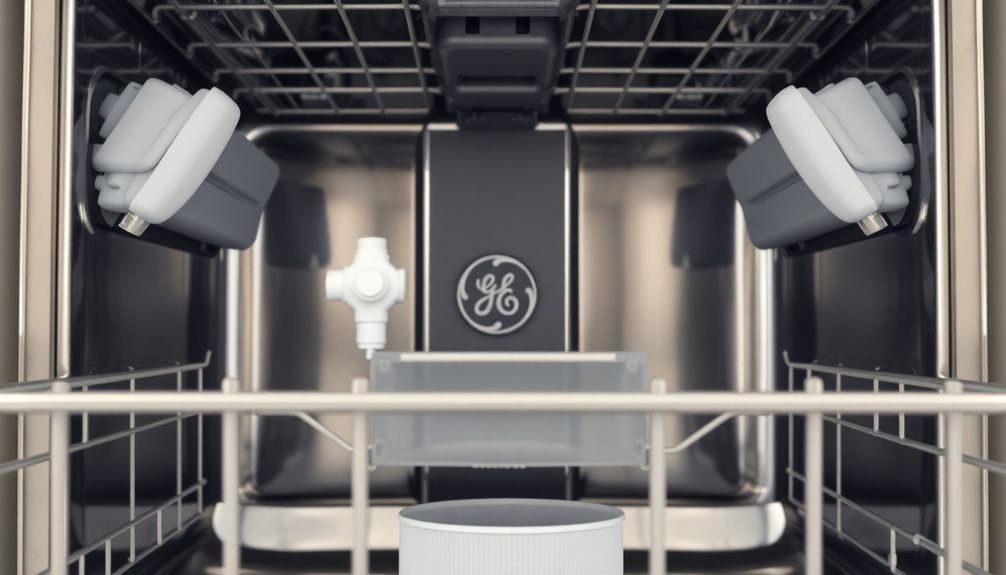
To keep your GE dishwasher running smoothly, regular maintenance is essential. Start by cleaning the float switch area to prevent blockages that can hinder water filling during wash cycles. This small task can greatly improve water flow and performance.
Next, inspect the water feed hoses for signs of wear or obstructions at least once every few months. Ensuring these hoses are in good condition is vital for proper water flow.
Additionally, periodically check and clean the spray arms. Debris can accumulate and affect their efficiency, so make sure they're free from any clogs.
Don't forget to maintain a clean interior by regularly removing food particles and residue. This simple practice will enhance water circulation and overall performance.
Keeping your dishwasher clean not only improves efficiency but also extends its lifespan.
Frequently Asked Questions
Why Is My GE Dishwasher Not GEtting Water?
If your GE dishwasher isn't getting water, check for a kinked hose, a clogged inlet valve, or a malfunctioning door switch. Also, inspect the float switch and filters, as they might be obstructed.
Why Does My Dishwasher Go Through Cycle but No Water?
If your dishwasher runs through its cycle but doesn't fill with water, check the float switch, water inlet valve, and supply hose for clogs or kinks. Regular maintenance can help prevent these issues.
Why Is My Dishwasher Not Washing During the Wash Cycle?
If your dishwasher isn't washing during the cycle, check for a kinked hose, clogged filter, or malfunctioning float switch. Regular maintenance can prevent these issues, ensuring your dishes come out clean after every wash.
Why Is My GE Dishwasher Not Starting the Wash Cycle?
Is your GE dishwasher refusing to start the wash cycle? Check if the door's securely closed, inspect the water supply for clogs, and verify the electrical connections are intact. Regular maintenance can prevent these frustrating issues.
Conclusion
If your GE dishwasher isn't getting water during the wash cycle, don't panic! Start by checking the water supply and inspecting the float switch. For instance, a user found that a kinked hose was the culprit, causing their dishwasher to malfunction. By straightening the hose, they restored water flow and saved money on repairs. Regular maintenance and attention to these common issues can keep your dishwasher running smoothly, ensuring you always have clean dishes when you need them.

